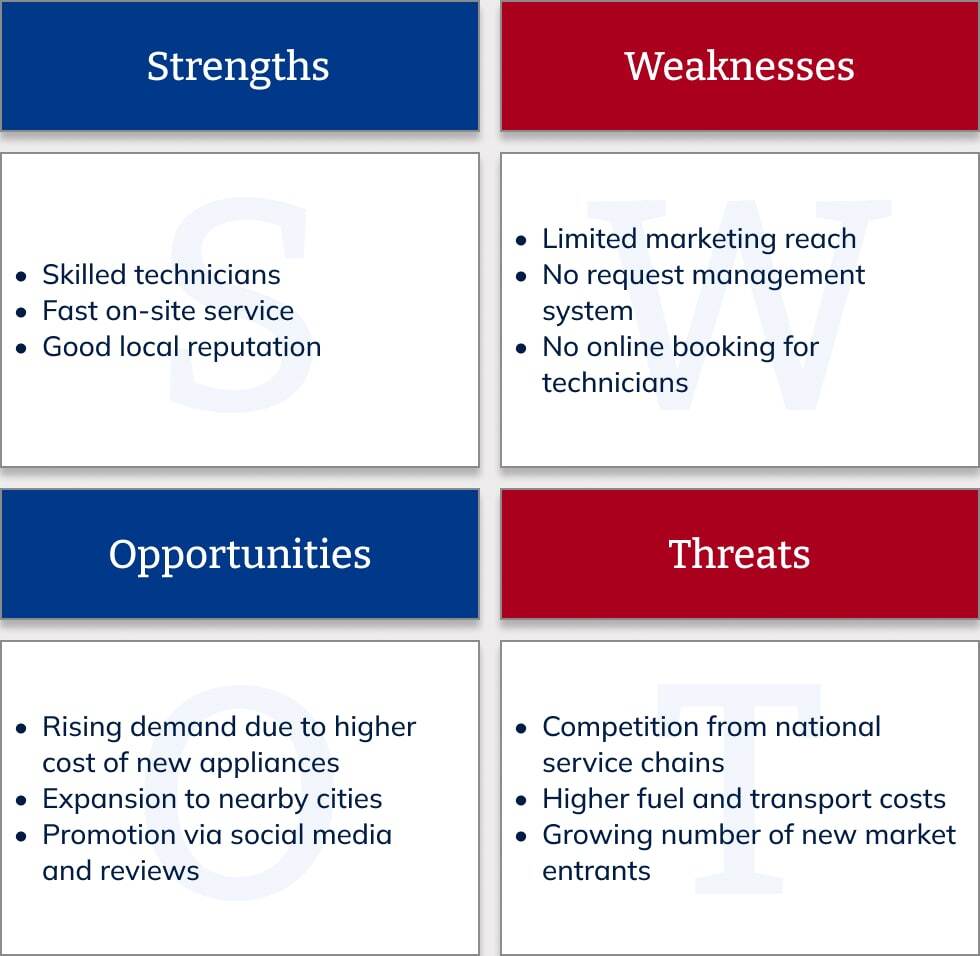SWOT analysis is like a strategic mirror for your business. It doesn’t provide ready-made solutions but allows you to look at your company from four angles: understand your strengths, recognize weaknesses, identify opportunities, and anticipate threats to your success. This “internal and external X-ray” helps you make sound management decisions and build a strategy based on reality, not assumptions.

What does the SWOT acronym mean?
SWOT analysis is a structured way to ask the right questions. It helps you break down your business into essential elements: where you excel, where you struggle, what waves you can ride, and where risks might hit.
It’s especially useful in times of uncertainty – when you're planning to expand, losing market share, or seeing unstable demand. It's a tool that mobilizes the team and moves thinking from the abstract to concrete actions.
It’s especially useful in times of uncertainty – when you're planning to expand, losing market share, or seeing unstable demand. It's a tool that mobilizes the team and moves thinking from the abstract to concrete actions.
SWOT analysis is a method of strategic diagnosis that allows for a systematic evaluation of a company's internal resources and limitations (strengths and weaknesses) and the external market situation (opportunities and threats).
The acronym stands for:
S – Strengths
W – Weaknesses
O – Opportunities
T – Threats
This approach helps you understand where your company stands now, what growth levers you have, and which external factors may influence your future.
S – Strengths
W – Weaknesses
O – Opportunities
T – Threats
This approach helps you understand where your company stands now, what growth levers you have, and which external factors may influence your future.
Where to start: setting a goal and taking an honest look at yourself
Before filling out the SWOT table, define your objective. Are you looking for growth points? Preparing to enter a new market? Trying to understand stagnation? A clearly stated goal gives the analysis focus and meaning.
Next comes data collection to build an objective picture of the company:
Use marketing data, HR reports, financial figures, competitive analysis – anything that helps you see the full picture in motion.
Next comes data collection to build an objective picture of the company:
- What do clients say? Employees? Partners?
- What do you do better than competitors?
- Where are the recurring problems?
- What external trends are in your favor – or working against you?
Use marketing data, HR reports, financial figures, competitive analysis – anything that helps you see the full picture in motion.
The essence of SWOT: four questions that shape strategy
Divide a sheet into four quadrants:
Important: Don’t fill in the table just for the sake of it. Discuss each point with your team and bring real-life examples from your company.
Example of a SWOT analysis for a fictional home appliance repair service:
- Strengths: Why do clients choose you? What do you do better than others? This may include a skilled team, a unique product, flexibility, or excellent customer service.
- Weaknesses: What’s holding you back? Long processes, staff shortages, a narrow range of services, or ineffective marketing.
- Opportunities: Where is the market offering you a chance? New niches, changes in legislation, digitalization, or government support.
- Threats: What might hit you tomorrow? Increased competition, economic instability, or falling demand.
Important: Don’t fill in the table just for the sake of it. Discuss each point with your team and bring real-life examples from your company.
Example of a SWOT analysis for a fictional home appliance repair service:

What’s next? Strategic conclusions and concrete actions
After completing the table, move on to the most important step – interpreting the data. At this stage, you can apply TOWS analysis – a developed version of SWOT where connections between categories are created.
Key questions include:
Answers to these questions form the foundation for strategic decision-making.
The results of the analysis should include:
Create a 3–6 month action plan with priorities, deadlines, and responsible people. SWOT is a starting point for change.
Key questions include:
- What strengths can help you seize opportunities?
- How can strengths be used to counter threats?
- What weaknesses prevent you from using opportunities?
- Which threats are worsened by internal vulnerabilities?
Answers to these questions form the foundation for strategic decision-making.
The results of the analysis should include:
- ideas for new products or markets;
- clarity on what needs to be automated or strengthened;
- risk management measures;
- a development strategy for the next quarter or year.
Create a 3–6 month action plan with priorities, deadlines, and responsible people. SWOT is a starting point for change.
SWOT – a practical tool for strategic planning
SWOT analysis is an invitation to have an honest conversation with yourself. It doesn’t require large budgets, but it does require engagement, analysis, and a willingness to adapt. For small businesses, it’s a chance to bring order to chaos. For large companies — a way to validate strategic direction.
Reach out to our experts – we’ll help you assess risks and financial prospects.




